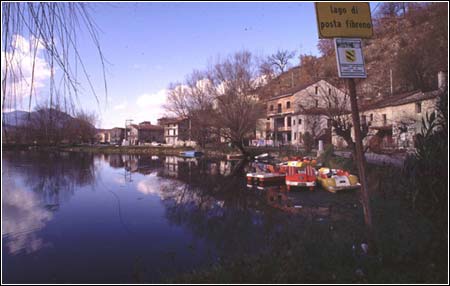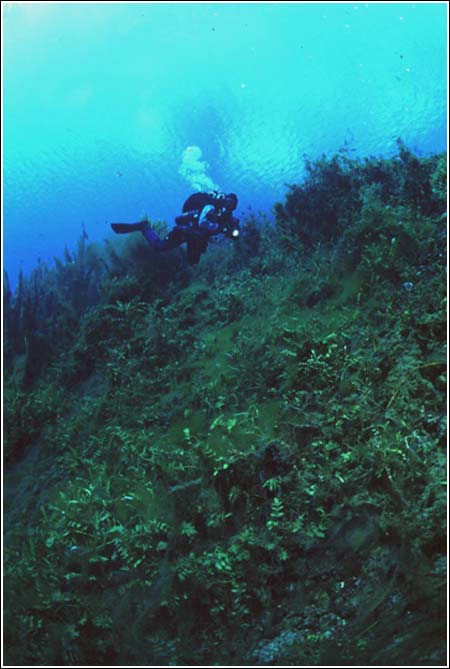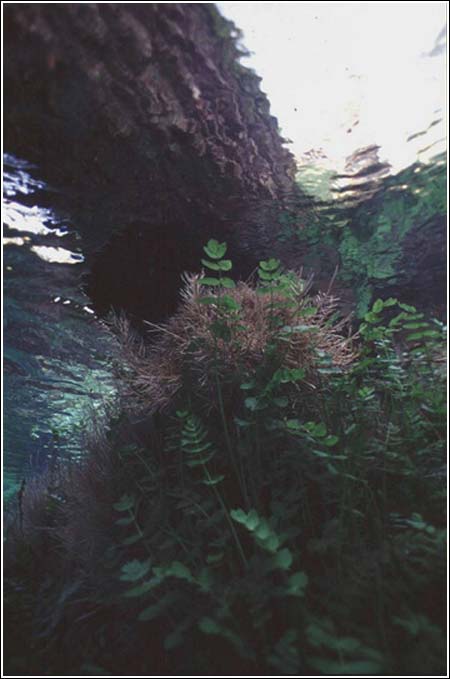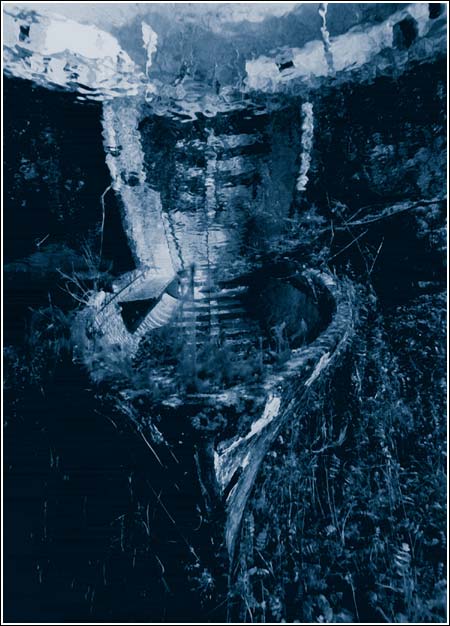The Lake of Posta Fibreno: A Natural Resource
By Elena Romano and Marcella Pesce
 |
|
Lake of Posta Fibreno Photo
by Claudio Provenzani
|
On the slopes of the Apennine mountain chain in central Italy, exists the lake of Posta Fibreno, which supports a unique ecosystem that has evolved as a result of the karstification of the mountain’s calcareous rocks. The rocks are largely composed of limestone, which has a high calcium carbonate (CaCO3) content and which accumulated over geological time in shallow water, forming rock layers.
The term “karst” gets its name from the Italian region of Carso, an area near the borders of what was once Yugoslavia. It is due, mainly, to two different processes: on one hand the strong erosive chemical power of the water, rich in carbon dioxide (CO2), which dissolves the limestone, and, on the other hand, the fine network of fractures, typical of calcareous rocks, that make it easier for water to penetrate below the surface.
On the surface, karst regions are marked by morphological
depressions in the land surface, while underground the erosion
caused by the water creates enormous caves with different shapes
and dimensions, according to the water circulation dynamics and its
erosive power. In dry sections of the caves, spectacular rock
formations like statues, alabaster walls or petrified waterfalls
are created by the downward flow of water through the caves.
Pillars span the space between floor and ceiling where stalagmites
and stalactites have joined together. All these structures are
created by the steady streams of water that slowly, but
continuously, deposit calcium carbonate (CaCO3) on the cave walls.
 |
|
Photo
by Claudio Provenzani
|
The underground flow of water creates subterranean networks of
rivers, waterfalls, lakes and siphons. Eventually, the water
flowing underground discharges at springs, which are another
characteristic feature of karst environments. The lake of Posta
Fibreno was formed as a consequence of the collection of water
discharging from numerous karstic springs at the foot of the
Apennine Mountains.
Thanks to its karstic origins, this lake has a temperature of
around 10°C (50°F) throughout the year. A few of the
characteristics of this lake, such as its elongated shape, the
speed of flow and the constant temperature at different depths and
times during the year make this lake a unique environment. Its flow
rate is approximately 9 cubic meters per second (20 million gallons
per day), which is considerably higher than the discharge from
normal lakes in the region. The river of Posta Fibreno originates
from the last narrow part of the lake.
In his “Natural History,” Pliny gives an account of a
peculiarity found at the Lake of Posta Fibreno: the lake is home to
a strange kind of island called “la rota.” This island,
formed over thousands of years through an accumulation of algae,
grass, shrubs and trees, is not anchored to the bottom of the lake
but is mobile, and moves in different directions depending on wind
velocity.
The lake basin is probably one of the most important components of the area’s ecosystem. It is, in fact, the hub of an entire ecosystem; pure waters, clear and icy, make it an ideal habitat for many species of animals and plants. In 1983, it was made a protected area in an effort to preserve its unique natural beauty.
The Lake of Posta Fibreno is well known to scuba divers seeking something different; but it is also famous among birdwatchers. At different times throughout the year, many species of birds, especially aquatic species, inhabit the bed of reeds along the beaches of the lake. Some of these species use this area to reproduce; others use it as a quiet resting site during or before migration.
Recently, the harmony that existed between the lake and its many species of birds has been disturbed by the introduction of an exotic species called the Coypu (Myocastor coypus), a mammal belonging to the order of Rodentia. Originally, the coypu was limited, geographically, to South America; however, in the 1950s it was introduced to many European countries, including Italy, in the hope of making easy money selling its pelt. This desire, however, quickly amounted to nothing, and, following the collapse of the fledgling industry, a large number of these animals were left to run wild without regard to what possible future impact they would have on the environment. The Coypu quickly and easily adapted to Italy’s climate and environment, and is now considered, as it is in many other countries, a pest-species. Environmentally speaking, its main negative impact is its destruction of the nests of many species of aquatic birds. Sometimes the eggs are eaten; sometimes they are not. But even if they are not, nest disruption is often responsible for the failure of some birds to reproduce successfully; in some cases, the bird species involved are rare. Furthermore, the area inhabitants do not care for the Coypu, mostly because it destroys crops.
 |
|
Photo by
Claudio Provenzani
|
 |
|
Lake of Posta
Fibreno Photo
by Claudio Provenzani
|
Despite their bad reputation, meeting a Coypus underwater is
still a fantastic experience, especially if one is lucky enough to
meet a brave individual or one accustomed to the presence of human
beings. Being careful not to scare it, observing the graceful
underwater movements of these animals is quite a treat. Viewing one
of these animals swimming free, in the clean, clear, cold waters of
the Lake of Posta Fibreno must surely be one of the most treasured
memories a scuba diver can have.
Diving into the cold waters of the Lake of Posta Fibreno is a
rewarding experience also thanks to the wonderful underwater
landscape created by blooming vegetation; algae and vascular plants
are plentiful, varying with depth and current strength. Naturally,
yearly seasonal changes will influence the appearance of this
natural display.
This abundance of vegetation is the base for an ecosystem that is also rich in animal species. Other than aquatic birds and the Coypu, fish are numerous and important inhabitants of these waters. Many of the more interesting encounters with fish occur during night dives, as many species of fish here are only active during night hours. Among the many fish species found here, it is important to highlight the presence of the “Carpione del Fibreno” (Salmo fibreni, Zerunian & Gandolfi 1990), an endemic species whose distribution is limited to this lake. The inhabitants of the area tell a story about this striking fish; they say that its beautiful colors are the result of its habit of eating the gold hidden on the beach of Posta Fibreno Lake. The Carpione del Fibreno belongs to the family Salmonidae, and is a shy and benthopelagic species that hides in cavities between rocks or in cover created by deep vegetation; reproduction takes place from December to January. This species is not listed in the Red Data Book of IUCN (International Union for the Conservation of Nature), but it is very likely to be an endangered species given the history of species of endemic trout that have been replaced, or genetically damaged, by hybridation following the introduction of other species of trout.
Also found in the lake is “Trota macrostigma” Salmo trutta macrostigma (Duméril 1855). According to HABITAT directive 92/43 EU, this species is listed as needing special attention. The Posta Fibreno population of this species is important, since it is one of the few still existing in central Italy. Trota macrostigma reproduces between February and March and grows to a larger size than Carpione del Fibreno. Studies conducted on this matter have theorized that one of the main factors that accounts for the coexistence of two species of trout in a confined habitat is their different period of reproduction.
Diving in the Lake of Posta Fibreno is very different from
diving in other places. The lake’s outstanding visibility
allows divers at depth to see people walking along the beaches of
the lake and clouds running across the sky. From behind the filter
of the clear, icy water of the lake at Posta Fibreno, the external
world, the non-aquatic world, appears very different. However, once
in the water, divers become a part of this vulnerable ecosystem, so
it is important that they be very careful not to disturb it;
excellent buoyancy control and a refined skill-set go a long way in
minimizing human impact on this beautiful, but fragile,
ecosystem.
Acknowledgements:
Thanks to Nick Connell for helping translate this article.
Additional Information on Posta Fibreno Lake:
The Natural Reserve of Posta Fibreno Lake was established to
promote the conservation and the rational utilization of this
natural environment. The protected area extends over the lake, the
bed of reeds and the upper part of the river Fibreno. Riserva
Naturale Lago di Posta Fibreno:
http://www.comune.posta-fibreno.fr.it
Copyright ©2002 Global
Underwater Explorers.
All rights reserved.

